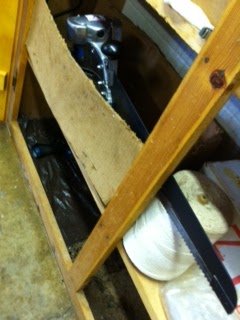 |
| Here's David on Saturday morning after breaking the loin down into chops on the band saw. |
The experience of “hugging your food” had suddenly gotten very “hands on” for me, and this time it wasn’t just about picking up a two-pound chicken running loose in a pasture. We were turning the animals into pork, a process that would take two whole days.
As we processed the whole carcasses, I was learning how true “everything but the oink” would be. There are aficionados for the organ meat – the heart, kidneys and liver – and there are people who eat these on their own merit. For us, they were mainly destined for the “pudding pot,” where we collected various cuts for use in scrapple that would be prepared on the second day.
 |
| Me, holding the "oink." |
 |
| The meat saw here, hard to see, is used to break the larger cuts down. |
 |
| Here are some of the parts waiting for the "pudding pot" - a small tenderloin, and sausage cuts. |
 |
| These are the big cuts that we had at the end of the first day. You can see a ham or two, loins, shoulders, and ribs in this photo. |
As our activities wrapped up and we were cleaning the shed, other family members began to show up to help with some organization for day 2, or to bring in some food and snacks. There was a good hour or two of socializing and catch up while things wound down. We planned for an 8:00 start the next morning, but I still had work to do, buying some spices and other goods for my sausage recipes.
I got home at 7:00 pm, grabbed a light dinner and some suds. I scrubbed myself down in a hot shower, and turned the lights out at 8:30. I woke up at 6:00 the next morning in the same position I went to sleep in, bone tired the night before, but refreshed and ready to go on a snowy Saturday morning.
No comments:
Post a Comment